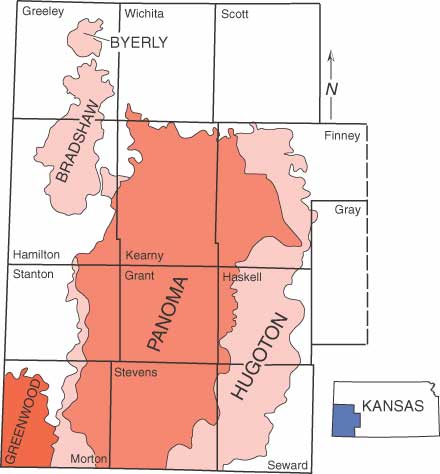| Kansas Geological Survey | Spring 1997 |
Vol. 3.2 |
|
Hugoton Pressure Declines Concern Irrigators
CONTENTS Hugoton Astronaut Delivers Lecture–page 3
|
If
the mainstays of agriculture are soil, water, and energy, then farmers
in southwestern Kansas should have it made. Underlying this corner of
the state are two enormous reservoirs of water and gas, the Ogallala aquifer
and, much deeper, the Hugoton natural gas area. For many years, farmers
in southwest Kansas have used Hugoton gas to fuel the nearly 10,000 irrigation
wells that pump water from the Ogallala aquifer. Lately, however, some farmers have had trouble getting the gas they need
to keep their pumps operating. It’s not that the Hugoton, the largest
gas reserve in North America, is out of gas. Geologists estimate that
the Hugoton contains 10 to 15 trillion cubic feet of natural gas (enough
for about 10 to 20 years at current production rates). But pressures in
the Hugoton, originally over 400 pounds per square inch (psi), have fallen
to around 90 psi. As long as reservoir pressures are higher than the surface pressure (14.7
psi), gas flows to the surface. Most irrigators buy their gas at the well
head, running it through their own pipeline to their irrigation pump.
“You need about 8 psi at the motor to run an irrigation pump,”
said Larry Kepley, a farmer from Ulysses. Because most irrigation pipelines
were installed back when Hugoton pressures were around 200 psi, some irrigators
used small-diameter pipe (1-1/4 to 2 inches) over long distances (1/2
to 2 miles) and still had 40 to 80 psi at the motor. But now, with pressures
in the low 90’s, the psi at the well head is only 20. “By
the time you run the gas through the small pipes over a mile or so, you
don’t have enough pressure to run the motor,” Kepley said. Irrigators aren’t alone in their concern about the Hugoton’s
declining pressures. At the current rate of decline, pressures will soon
be so low that the cost of bringing the gas to the surface will exceed
its value. But, according to geologist Tim Carr at the Kansas Geological
Survey, gas companies are taking steps to ensure that Hugoton gas will
continue to be profitable. “Companies have had to apply more technology
and look closer at what they can get out of this resource,” said
Carr. In addition to installing compressors to increase pressure in the
pipelines, gas companies are drilling new wells and using new technologies
to target new production zones. “Because the Hugoton is such a vast
resource, even a one percent increase in production will generate many
millions of dollars,” said Carr. Surprisingly, given the economic importance of the Hugoton natural gas
area, no field-wide study has ever been conducted. Recently the Kansas
Geological Survey proposed a five-year study of the entire natural gas
area, a study that would pull together data from over 12,000 wells in
the Hugoton. “The study would provide a much needed common base
of information,” said Survey geologist Lynn Watney. By providing
a consistent geological picture of the region, a comprehensive study would
generate better estimates of how much gas remains in the Hugoton area.
In addition, the study would provide the geologic information needed to
locate new reserves and more efficiently produce known reserves. Watney stressed the importance of a solid knowledge base at a recent public forum on the declining pressures in the Hugoton. Among those who testified at the March 12th meeting organized by the Southwest Kansas Irrigators Association were farmers, representatives of the gas industry, state senators and representatives, and staff from other state agencies. “We didn’t expect to come up with one solution,” said Kepley. “The important thing is that folks are working appropriately to find answers.” |
|
The major gas fields of the Hugoton natural gas area
in Kansas. |
 |
|
Online February 10, 2003 Comments to: lbrosius@kgs.ku.edu Kansas Geological Survey URL:http://www.kgs.ku.edu/Publications/GeoRecord/1997/vol3.2/Page1.html |